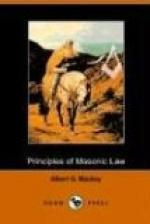It is also certain that the office of Deacon claims an earlier origin in America than the “very latter end of the eighteenth century;” and, as an evidence of this, it may be stated that, in the “Ahiman Rezon” of Pennsylvania, published in 1783, the Grand Deacons are named among the officers of the Grand Lodge, “as particular assistants to the Grand Master and Senior Warden, in conducting the business of the Lodge.” They are to be found in all Grand Lodges of the York Rite, and are usually appointed, the Senior by the Grand Master, and the Junior by the Senior Grand Warden.
Section VIII.
Of the Grand Marshal.
The Grand Marshal, as an officer of convenience, existed from an early period. We find him mentioned in the procession of the Grand Lodge, made in 1731, where he is described as carrying “a truncheon, blue, tipped with gold,” insignia which he still retains. He takes no part in the usual work of the Lodge; but his duties are confined to the proclamation of the Grand Officers at their installation, and to the arrangement and superintendence of public processions.
The Grand Marshal is usually appointed by the Grand Master.
Section IX.
Of the Grand Stewards.
The first mention that is made of Stewards is in the Old Regulations, adopted in 1721. Previous to that time, the arrangements of the Grand Feast were placed in the hands of the Grand Wardens; and it was to relieve them of this labor that the regulation was adopted, authorizing the Grand Master, or his Deputy, to appoint a certain number of Stewards, who were to act in concert with the Grand Wardens. In 1728, it was ordered that the number of Stewards to be appointed should be twelve. In 1731, a regulation was adopted, permitting the Grand Stewards to appoint their successors. And, in 1735, the Grand Lodge ordered, that, “in consideration of their past service and future usefulness,” they should be constituted a Lodge of Masters, to be called the Stewards’ Lodge, which should have a registry in the Grand Lodge list, and exercise the privilege of sending twelve representatives. This was the origin of that body now known in the Constitutions of the Grand Lodges of England and New York,[28] as the Grand Stewards’ Lodge, although it has been very extensively modified in its organization. In New York, it is now no more than a Standing Committee of the Grand Lodge; and in England, although it is regularly constituted, as a Lodge of Master Masons, it is by a special regulation deprived of all power of entering, passing, or raising Masons. In other jurisdictions, the office of Grand Stewards is still preserved, but their functions are confined to their original purpose of preparing and superintending the Grand Feast.
The appointment of the Grand Stewards should be most appropriately vested in the Junior Grand Warden.
Section X.
Of the Grand Sword-Bearer.




